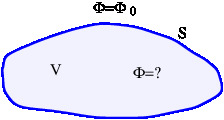The solution of Poisson equation in a region, is unique for a specified charge density and under given boundary conditions. The uniqueness theorem is explained by means of several simple examples.
Uniqueness Theorem
Let $V$ be a volume bounded by a surface $S$. The solution of Laplace equation \begin{align} \nabla^2\Phi =0 \end{align} in region $V$ subject to specified value of $\Phi$ on the boundary $S$ is unique.
In another words if $\Phi_1$ and $\Phi_2$ are two solutions of Laplace equation ($\otimes$)
\begin{align}
\nabla^2\Phi=\rho
\end{align}
and of $\Phi_1=\Phi_2$ on the boundary $S$ then $\Phi_1=\Phi_2$ every where in volume $V$.
Thus if charge density is known in volume $V$ and the potential is specified on boundary $S$, then the potential is uniquely determined.
Simple Examples
Example 1
Let $S$ be a grounded conducting shell of arbitrary shape with no
charges enclosed by the surface $S$.

The potential in volume $V$ enclosed by \(S\) is a solution of
$$
\nabla^2\Phi = 0\qquad\qquad \text{in}~V
$$
subject to boundary condition $\Phi=\Phi_0$. We can easily guess the solution $\Phi$ to be \(\Phi_0\) for all points in volume $V$. That this guess is the correct answer follows from the uniqueness theorem.
Example 2
Suppose we are given a grounded conducting shell of {\bf arbitrary shape} and that the charged density inside the shell is some arbitrary distribution $\rho$ and is zero outside. We want to find the electric field outside the conductor subject to potential.
The constant potential \(\Phi(\vec r)=0\) outside the shell satisfies the Laplace equation everywhere outside the volume \(V\) as well as the boundary condition on the surface of the shell.
Therefore the uniqueness theorem implies that
\(\Phi=0\) outside the shell is the correct answer. Hence the electric field outside the shell will be zero. Thus charge distribution inside the grounded shell does not produce any effect outside the shell. This is known as shielding of charge by a grounded conductor.
Example 3
Consider two problems I and II given below.
Problem 1
A spherical conductor of radius \(R\) held at constant potential \(\Phi_0\). We want to find the potential outside the conductor subject to potential tending to zero at infinity.
Thus we need to find the potential for \(r>R\) subject to the boundary condition\\
\[\Phi=\Phi_0, \text{ for } r =R.\]
The Problem-I can be solved by making use of the known solution of Problem-II of potential due to a point charge as explained below.
Problem II
Consider the problem with a point charge $Q$ at the origin and no conductor present.
The potential of the point charge at a distance \(r\) is known to be
\[ \Phi(r) =\frac{Q}{4\pi\epsilon_0r} \]
On the surface of a sphere of radius \(R\) the potential has the value \(\frac{Q}{4\pi\epsilon_0R}\). If we set \(Q=4\pi\epsilon_0 R \Phi_0\), then the potential of the point charge in region \(r>R\) satisfies
\begin{equation}\label{EQ03}
\Phi(r) = \begin{cases}
\Phi_0 & \text{if}\quad r=R \\
0 & \text{as} \quad r\to \infty
\end{cases}
\end{equation}
and is given by
\begin{equation}\label{EQ04}
\Phi(r) = \Phi_0 (R/r) \qquad \text{for } r> R\qquad \,.
\end{equation}
The boundary condition in \eqref{EQ03} coincide with that for Problem-I outside the shell. Also in both cases the charge density for \(r>R\) is zero. Therefore, by appealing to uniqueness theorem, the answer for Problem-I is given by \eqref{EQ04}.
Example 4
A conducting shell of arbitrary shape has net charge $Q$. The conducting shell, being an equipotential surface will have some potential $\Phi_0$. Suppose there is no charge inside the
surface. Thus we are given
\begin{eqnarray*}
\rho &=& 0\qquad \text{inside volume}\quad V,\\
\Phi&=& \Phi_0 \quad \text{on surface} S
\end{eqnarray*}
Then a solution of Laplace equation inside $S$ is $\Phi=\Phi_0$
everywhere in $V$. The uniqueness theorem guarantees that this is also the correct answer.
This shows that the electric field inside an empty conducting shell is zero. This means that the electric field and charges outside the shell have no effect on the region inside. Thus the conductor shields the region inside the shell from charges and electric field outside. It may be emphasized that this statement, as proved here, holds for static charges and fields.
Example 5
An argument, similar to that in example 4, shows that if there are no charges outside a volume $V$ enclosed by a surface $S$, then the potential outside the surface must be a constant and therefore the electric field outside $S$ will be zero.






 ||Message]
||Message]
